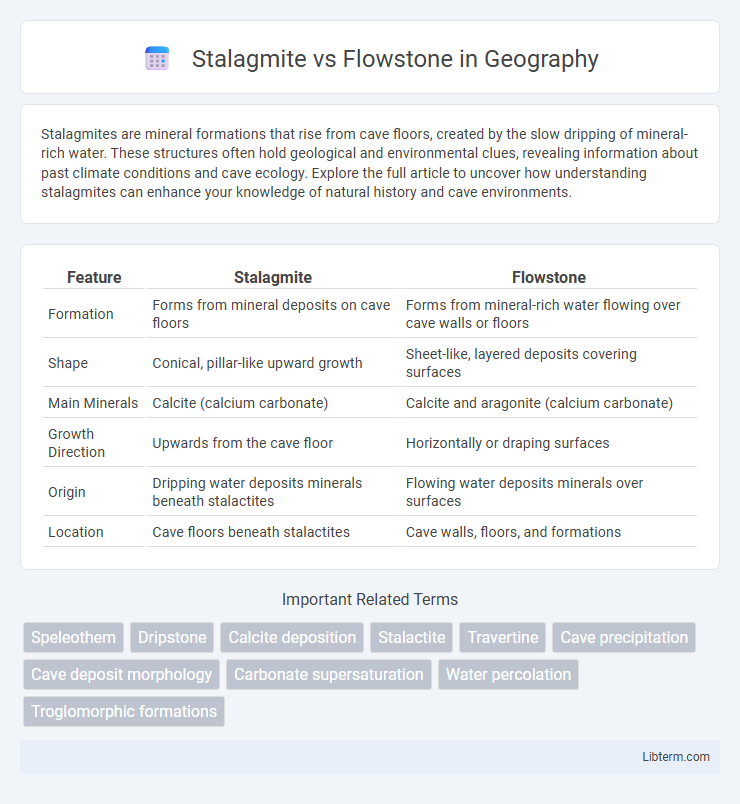Stalagmites are mineral formations that rise from cave floors, created by the slow dripping of mineral-rich water. These structures often hold geological and environmental clues, revealing information about past climate conditions and cave ecology. Explore the full article to uncover how understanding stalagmites can enhance your knowledge of natural history and cave environments.
Table of Comparison
| Feature | Stalagmite | Flowstone |
|---|---|---|
| Formation | Forms from mineral deposits on cave floors | Forms from mineral-rich water flowing over cave walls or floors |
| Shape | Conical, pillar-like upward growth | Sheet-like, layered deposits covering surfaces |
| Main Minerals | Calcite (calcium carbonate) | Calcite and aragonite (calcium carbonate) |
| Growth Direction | Upwards from the cave floor | Horizontally or draping surfaces |
| Origin | Dripping water deposits minerals beneath stalactites | Flowing water deposits minerals over surfaces |
| Location | Cave floors beneath stalactites | Cave walls, floors, and formations |
Introduction to Cave Formations
Stalagmites form from mineral deposits that accumulate vertically on cave floors as water drips down, creating upward-pointing structures primarily composed of calcite. Flowstone develops as thin sheets of mineral deposits flow over cave walls or floors, producing smooth, layered formations formed by mineral-rich water flowing continuously. Both stalagmites and flowstones are integral to speleothem classification, reflecting different patterns of mineral precipitation in karst environments.
What is a Stalagmite?
A stalagmite is a type of speleothem found on cave floors, formed by the accumulation of mineral deposits from dripping water. Composed primarily of calcium carbonate, stalagmites grow upward as minerals precipitate from water droplets falling from the cave ceiling. Unlike flowstone, which forms sheet-like deposits along cave walls or floors, stalagmites have a more conical or mound-shaped structure, developing directly beneath stalactites.
What is a Flowstone?
Flowstone is a type of speleothem formed by the continuous deposition of calcium carbonate or other minerals from flowing water over cave floors and walls, creating smooth, sheet-like mineral formations. Unlike stalagmites, which grow upward from cave floors due to dripping water, flowstones develop as thin, often glossy layers that spread laterally. This mineral buildup results from water rich in dissolved calcite that loses carbon dioxide and precipitates minerals along its path.
Formation Processes: Stalagmites vs Flowstones
Stalagmites form from dripping water that deposits mineral-rich solutions directly onto cave floors, causing upward growth through the accumulation of calcium carbonate or other minerals. Flowstones develop as water flows in thin sheets over cave walls or floors, depositing layered mineral deposits that create smooth, often sheet-like formations. The primary distinction lies in stalagmites growing from dripping points, while flowstones form from continuous water flow along surfaces.
Key Differences Between Stalagmites and Flowstones
Stalagmites form from mineral deposits that accumulate vertically upward on cave floors, primarily composed of calcite or aragonite, while flowstones develop as sheet-like formations on cave walls or floors due to flowing water depositing layers of calcium carbonate. Stalagmites have a distinctive upward cone or mound shape, whereas flowstones exhibit smooth, draped surfaces resembling frozen waterfalls. The growth rate of stalagmites is generally slower and more dependent on drip water, contrasting with flowstones, which form continuously from flowing water across larger cave surfaces.
Physical Characteristics and Appearance
Stalagmites form from mineral deposits rising from the floor of caves, typically exhibiting a conical or cylindrical shape with a rough, uneven texture. Flowstone, in contrast, develops as sheet-like deposits on cave walls or floors, characterized by smooth, layered surfaces resembling flowing sheets of rock. The color variations in both are influenced by impurities, with stalagmites often appearing in warm earth tones while flowstone can show a broader spectrum of hues due to mineral content.
Geological Importance and Function
Stalagmites and flowstones are crucial geological formations in caves, each representing different mineral deposition processes. Stalagmites form upward from the cave floor through the accumulation of drip water rich in calcium carbonate, providing insights into past climatic conditions and water chemistry. Flowstones develop as sheets of calcite or other minerals on cave walls or floors from flowing water, serving as valuable records of environmental changes and geochemical processes over time.
Locations Where Stalagmites and Flowstones Are Found
Stalagmites primarily form on cave floors beneath stalactites where mineral-laden water drips, most notably in limestone caves such as Carlsbad Caverns in New Mexico and Mammoth Cave in Kentucky. Flowstones, created by mineral-rich water flowing over walls or floors, are commonly found in similar karst environments but are especially prominent in caves like Luray Caverns in Virginia and the Jenolan Caves in Australia. Both formations thrive in humid caves with abundant calcium carbonate deposits, with their distinctive shapes marking areas of differing water flow and mineral deposition.
Conservation and Preservation of Cave Formations
Stalagmites and flowstones are delicate cave formations that require careful conservation to prevent damage from human interaction and environmental changes. Effective preservation techniques include regulating cave access, controlling humidity and temperature, and minimizing physical contact to protect these calcite structures from erosion and contamination. Scientific monitoring and public education play crucial roles in sustaining the natural growth of stalagmites and flowstones for future generations.
Summary: Stalagmite vs Flowstone Comparison
Stalagmites are mineral formations that rise from cave floors, created by the accumulation of dripping water rich in calcium carbonate, while flowstones are sheet-like deposits formed by water flowing over cave walls or floors. Both are types of speleothems commonly found in limestone caves, but stalagmites grow vertically from the ground whereas flowstones spread out in thin layers along surfaces. Their distinct growth patterns and shapes aid geologists and speleologists in understanding cave environments and hydrological processes.
Stalagmite Infographic

 libterm.com
libterm.com